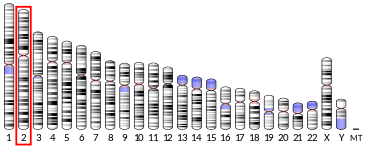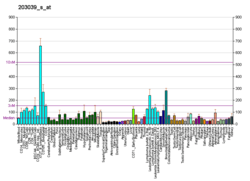NDUFS1
NADH-ubiquinone oxidoreductase 75 kDa subunit, mitochondrial (NDUFS1) is an enzyme that in humans is encoded by the NDUFS1 gene.[5] The encoded protein, NDUFS1, is the largest subunit of complex I, located on the inner mitochondrial membrane, and is important for mitochondrial oxidative phosphorylation. Mutations in this gene are associated with complex I deficiency.[6]
Structure
NDUFS1 is located on the q arm of chromosome 2 in position 33.3 and has 20 exons.[7] The NDUFS1 gene produces a 79.5 kDa protein composed of 727 amino acids.[8][9] NDUFS1, the protein encoded by this gene, is a member of the complex I 75 kDa subunit family. It contains a transit peptide, 10 turns, 19 beta strands, 27 alpha helixes, and cofactor binding sites for [2Fe-2S] and [4Fe-4S] clusters. The cluster domains consist of a 79 amino acid 2Fe-2S ferredoxin-type from positions 30-108, a 40 amino acid 4Fe-4S His(Cys)3-ligated-type from positions 108-147, and a 57 amino acid 4Fe-4S Mo/W bis-MGD-type from positions 245-301.[10][11] Several transcript variants encoding different isoforms have been found for this gene.[6]
Function
The protein encoded by this gene belongs to the complex I 75 kDa subunit family. Mammalian complex I is composed of 45 different subunits. It locates at the mitochondrial inner membrane. This protein has NADH dehydrogenase activity and oxidoreductase activity. It transfers electrons from NADH to the respiratory chain. The immediate electron acceptor for the enzyme is believed to be ubiquinone. This protein is the largest subunit of complex I and it is a component of the iron-sulfur (IP) fragment of the enzyme. It may form part of the active site crevice where NADH is oxidized.[6]
Clinical significance
Mutations in the NDUFS1 gene are associated with Mitochondrial Complex I Deficiency, which is autosomal recessive. This deficiency is the most common enzymatic defect of the oxidative phosphorylation disorders.[12][13] Mitochondrial complex I deficiency shows extreme genetic heterogeneity and can be caused by mutation in nuclear-encoded genes or in mitochondrial-encoded genes. There are no obvious genotype-phenotype correlations, and inference of the underlying basis from the clinical or biochemical presentation is difficult, if not impossible.[14] However, the majority of cases are caused by mutations in nuclear-encoded genes.[15][16] It causes a wide range of clinical disorders, ranging from lethal neonatal disease to adult-onset neurodegenerative disorders. Phenotypes include macrocephaly with progressive leukodystrophy, nonspecific encephalopathy, hypertrophic cardiomyopathy, myopathy, liver disease, Leigh syndrome, Leber hereditary optic neuropathy, and some forms of Parkinson disease.[17]
Interactions
NDUFS1 has been shown to have 124 binary protein-protein interactions including 110 co-complex interactions. NDUFS1 appears to interact with SOAT1, NDUFA9, HLA-B, ECE2, C1QTNF9, GPAA1, STOM, GDI1, ACAP2, EHBP1, MBOAT7, PIGS.[18]
See also
References
- ENSG00000283447 GRCh38: Ensembl release 89: ENSG00000023228, ENSG00000283447 - Ensembl, May 2017
- GRCm38: Ensembl release 89: ENSMUSG00000025968 - Ensembl, May 2017
- "Human PubMed Reference:". National Center for Biotechnology Information, U.S. National Library of Medicine.
- "Mouse PubMed Reference:". National Center for Biotechnology Information, U.S. National Library of Medicine.
- Chow W, Ragan I, Robinson BH (November 1991). "Determination of the cDNA sequence for the human mitochondrial 75-kDa Fe-S protein of NADH-coenzyme Q reductase". European Journal of Biochemistry. 201 (3): 547–50. doi:10.1111/j.1432-1033.1991.tb16313.x. PMID 1935949.
- "Entrez Gene: NDUFS1 NADH dehydrogenase (ubiquinone) Fe-S protein 1, 75kDa (NADH-coenzyme Q reductase)".

- "Entrez Gene: Cytochrome c oxidase assembly factor 7 (putative)". Retrieved 2018-08-08.

- Yao, Daniel. "Cardiac Organellar Protein Atlas Knowledgebase (COPaKB) —— Protein Information". amino.heartproteome.org. Retrieved 2018-08-27.
- Zong NC, Li H, Li H, Lam MP, Jimenez RC, Kim CS, et al. (October 2013). "Integration of cardiac proteome biology and medicine by a specialized knowledgebase". Circulation Research. 113 (9): 1043–53. doi:10.1161/CIRCRESAHA.113.301151. PMC 4076475. PMID 23965338.
- "NDUFS1 - NADH-ubiquinone oxidoreductase 75 kDa subunit, mitochondrial precursor - Homo sapiens (Human) - NDUFS1 gene & protein". www.uniprot.org. Retrieved 2018-08-27.

- "UniProt: the universal protein knowledgebase". Nucleic Acids Research. 45 (D1): D158–D169. January 2017. doi:10.1093/nar/gkw1099. PMC 5210571. PMID 27899622.
- Kirby DM, Salemi R, Sugiana C, Ohtake A, Parry L, Bell KM, Kirk EP, Boneh A, Taylor RW, Dahl HH, Ryan MT, Thorburn DR (September 2004). "NDUFS6 mutations are a novel cause of lethal neonatal mitochondrial complex I deficiency". The Journal of Clinical Investigation. 114 (6): 837–45. doi:10.1172/JCI20683. PMC 516258. PMID 15372108.
- McFarland R, Kirby DM, Fowler KJ, Ohtake A, Ryan MT, Amor DJ, Fletcher JM, Dixon JW, Collins FA, Turnbull DM, Taylor RW, Thorburn DR (January 2004). "De novo mutations in the mitochondrial ND3 gene as a cause of infantile mitochondrial encephalopathy and complex I deficiency". Annals of Neurology. 55 (1): 58–64. doi:10.1002/ana.10787. PMID 14705112.
- Haack TB, Haberberger B, Frisch EM, Wieland T, Iuso A, Gorza M, Strecker V, Graf E, Mayr JA, Herberg U, Hennermann JB, Klopstock T, Kuhn KA, Ahting U, Sperl W, Wilichowski E, Hoffmann GF, Tesarova M, Hansikova H, Zeman J, Plecko B, Zeviani M, Wittig I, Strom TM, Schuelke M, Freisinger P, Meitinger T, Prokisch H (April 2012). "Molecular diagnosis in mitochondrial complex I deficiency using exome sequencing" (PDF). Journal of Medical Genetics. 49 (4): 277–83. doi:10.1136/jmedgenet-2012-100846. PMID 22499348.
- Loeffen JL, Smeitink JA, Trijbels JM, Janssen AJ, Triepels RH, Sengers RC, van den Heuvel LP (2000). "Isolated complex I deficiency in children: clinical, biochemical and genetic aspects". Human Mutation. 15 (2): 123–34. doi:10.1002/(SICI)1098-1004(200002)15:2<123::AID-HUMU1>3.0.CO;2-P. PMID 10649489.
- Triepels RH, Van Den Heuvel LP, Trijbels JM, Smeitink JA (2001). "Respiratory chain complex I deficiency". American Journal of Medical Genetics. 106 (1): 37–45. doi:10.1002/ajmg.1397. PMID 11579423.
- Robinson BH (May 1998). "Human complex I deficiency: clinical spectrum and involvement of oxygen free radicals in the pathogenicity of the defect". Biochimica et Biophysica Acta (BBA) - Bioenergetics. 1364 (2): 271–86. doi:10.1016/s0005-2728(98)00033-4. PMID 9593934.
- "124 binary interactions found for search term NDUFS1". IntAct Molecular Interaction Database. EMBL-EBI. Retrieved 2018-08-25.
Further reading
- Baertling F, Schaper J, Mayatepek E, Distelmaier F (July 2013). "Teaching NeuroImages: rapidly progressive leukoencephalopathy in mitochondrial complex I deficiency". Neurology. 81 (2): e10-1. doi:10.1212/WNL.0b013e31829a339b. PMID 23836946.
- Duncan AM, Chow W, Robinson BH (1992). "Localization of the human 75-kDal Fe-S protein of NADH-coenzyme Q reductase gene (NDUFS1) to 2q33----q34". Cytogenetics and Cell Genetics. 60 (3–4): 212–3. doi:10.1159/000133340. PMID 1505218.
- Sumegi B, Srere PA (December 1984). "Complex I binds several mitochondrial NAD-coupled dehydrogenases". The Journal of Biological Chemistry. 259 (24): 15040–5. PMID 6439716.
- Loeffen JL, Triepels RH, van den Heuvel LP, Schuelke M, Buskens CA, Smeets RJ, Trijbels JM, Smeitink JA (December 1998). "cDNA of eight nuclear encoded subunits of NADH:ubiquinone oxidoreductase: human complex I cDNA characterization completed". Biochemical and Biophysical Research Communications. 253 (2): 415–22. doi:10.1006/bbrc.1998.9786. PMID 9878551.
- Bénit P, Chretien D, Kadhom N, de Lonlay-Debeney P, Cormier-Daire V, Cabral A, Peudenier S, Rustin P, Munnich A, Rötig A (June 2001). "Large-scale deletion and point mutations of the nuclear NDUFV1 and NDUFS1 genes in mitochondrial complex I deficiency". American Journal of Human Genetics. 68 (6): 1344–52. doi:10.1086/320603. PMC 1226121. PMID 11349233.
- Ricci JE, Muñoz-Pinedo C, Fitzgerald P, Bailly-Maitre B, Perkins GA, Yadava N, Scheffler IE, Ellisman MH, Green DR (June 2004). "Disruption of mitochondrial function during apoptosis is mediated by caspase cleavage of the p75 subunit of complex I of the electron transport chain". Cell. 117 (6): 773–86. doi:10.1016/j.cell.2004.05.008. PMID 15186778.
- Martín MA, Blázquez A, Gutierrez-Solana LG, Fernández-Moreira D, Briones P, Andreu AL, Garesse R, Campos Y, Arenas J (April 2005). "Leigh syndrome associated with mitochondrial complex I deficiency due to a novel mutation in the NDUFS1 gene". Archives of Neurology. 62 (4): 659–61. doi:10.1001/archneur.62.4.659. PMID 15824269.
- Rual JF, Venkatesan K, Hao T, Hirozane-Kishikawa T, Dricot A, Li N, Berriz GF, Gibbons FD, Dreze M, Ayivi-Guedehoussou N, Klitgord N, Simon C, Boxem M, Milstein S, Rosenberg J, Goldberg DS, Zhang LV, Wong SL, Franklin G, Li S, Albala JS, Lim J, Fraughton C, Llamosas E, Cevik S, Bex C, Lamesch P, Sikorski RS, Vandenhaute J, Zoghbi HY, Smolyar A, Bosak S, Sequerra R, Doucette-Stamm L, Cusick ME, Hill DE, Roth FP, Vidal M (October 2005). "Towards a proteome-scale map of the human protein-protein interaction network". Nature. 437 (7062): 1173–8. Bibcode:2005Natur.437.1173R. doi:10.1038/nature04209. PMID 16189514.
- Iuso A, Scacco S, Piccoli C, Bellomo F, Petruzzella V, Trentadue R, Minuto M, Ripoli M, Capitanio N, Zeviani M, Papa S (April 2006). "Dysfunctions of cellular oxidative metabolism in patients with mutations in the NDUFS1 and NDUFS4 genes of complex I". The Journal of Biological Chemistry. 281 (15): 10374–80. doi:10.1074/jbc.M513387200. PMID 16478720.
- Piccoli C, Scacco S, Bellomo F, Signorile A, Iuso A, Boffoli D, Scrima R, Capitanio N, Papa S (August 2006). "cAMP controls oxygen metabolism in mammalian cells". FEBS Letters. 580 (18): 4539–43. doi:10.1016/j.febslet.2006.06.085. PMID 16870178.
External links
- Overview of all the structural information available in the PDB for UniProt: P28331 (NADH-ubiquinone oxidoreductase 75 kDa subunit, mitochondrial) at the PDBe-KB.
This article incorporates text from the United States National Library of Medicine, which is in the public domain.




